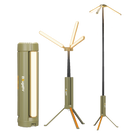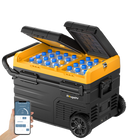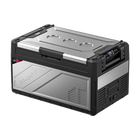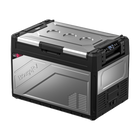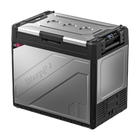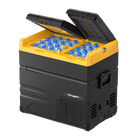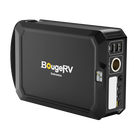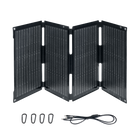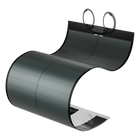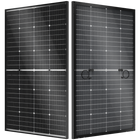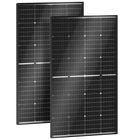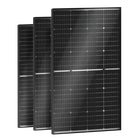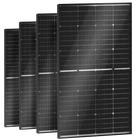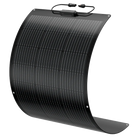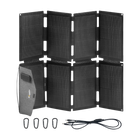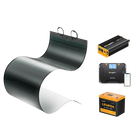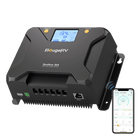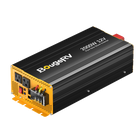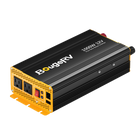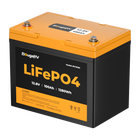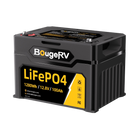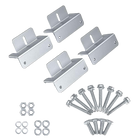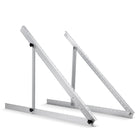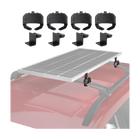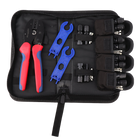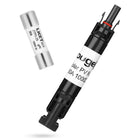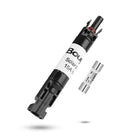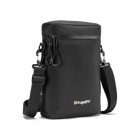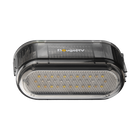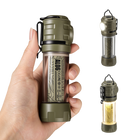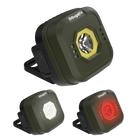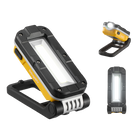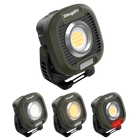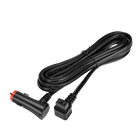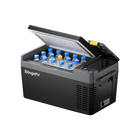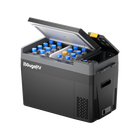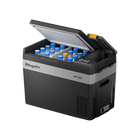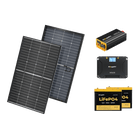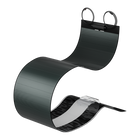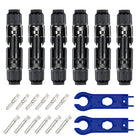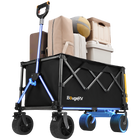How To Calculate Solar Panel Output?


Understanding how to calculate solar panel output is crucial to making informed decisions about your solar energy system. By accurately estimating the potential energy production, you can optimize your system's size, maximize its efficiency, and evaluate its overall performance.
In this guide, we will walk you through the key factors and formulas involved in calculating solar panel output, empowering you to make better choices and harness the full potential of solar energy.
What Are Solar Panels?
Solar panels, often called photovoltaic (PV) panels, are innovative devices that harness the power of sunlight and convert it into electricity. They have revolutionized how we generate energy, providing a clean and bearable alternative to traditional fossil fuel-based sources. Solar panels have a broad range of applications, from powering homes and businesses to supporting remote areas with little access to the power grid.
Among the various types of solar panel volts available, the 12V solar panel is among the top and stands out for its versatility and efficiency. These panels are suitable for charging batteries commonly used in RVs, boats, and other similar setups.
They are weightless, portable, and easy to install, making them popular for outdoor enthusiasts and those seeking alternative power sources in remote locations.
Advantages Of Solar Panel

Let's explore some benefits of solar panels in-depth, highlighting their positive impact on the environment, economy, and individuals.
- Renewable Energy Source: Solar energy is a renewable resource that is naturally replenished and virtually limitless. Unlike fossil fuels, which are limited and contribute to greenhouse gas emissions, solar power relies on the sun's energy to generate power.
- Environmentally Friendly: Solar panels produce clean energy without emitting harmful pollutants or greenhouse gases. They help reduce carbon dioxide (CO2) emissions, contributing to climate change. By harnessing the sun's energy, solar panels contribute to a greener and healthier planet, mitigating the negative effects of traditional energy sources.
- Energy Cost Savings: Installing solar panels can significantly save electricity bills. Once the initial investment is recovered, the energy generated by solar panels is essentially free.
- Energy Independence: Solar panels allow individuals and businesses to become more self-sufficient by generating their electricity. Solar panel owners can hedge against rising energy prices and potential power outages by reducing reliance on the traditional power grid.
- Low Maintenance and Long Lifespan: Solar panels require minimal maintenance, making them a hassle-free investment. Typically, occasional cleaning and inspection are sufficient to ensure optimal performance. Additionally, solar panels have a long lifespan, often exceeding 25 years, translating to decades of clean energy production.
- Diverse Applications: Solar panels can be installed in various settings, ranging from residential rooftops to large-scale solar farms. This versatility allows for widespread adoption and integration into different environments. Solar-powered water heaters, calculators, streetlights, and even spacecraft demonstrate the diverse applications of solar technology.
- Technological Advancements: Ongoing research and development in solar technology have resulted in continuous improvements in efficiency and affordability.
What To Consider When Calculating Solar Panel Output?

As more individuals and businesses consider installing solar panels, it is essential to understand the factors that can affect solar panel output. Several key elements influence the efficiency and overall performance of solar panels, including factors:
Solar Panel Efficiency:
Solar panel efficiency refers to the ability of the panels to convert sunlight into usable electricity. Higher-efficiency panels can produce more electricity for a given amount of sunlight.
Several factors can influence solar panel efficiency, including dust accumulation, dirt on solar panels, and shading caused by nearby trees, buildings, or other obstructions that can obstruct sunlight and impact panel output.
Solar panels perform best under direct sunlight but can still generate electricity on overcast days. However, the intensity of sunlight affects the panel's output. Rain, snow, and fog can also temporarily reduce solar panel efficiency. Therefore, the local climate and weather patterns should be considered when calculating solar panel output.
Location and Orientation Affect Solar Output:
The location and orientation of solar panels play a vital role in determining their energy production. Consider the following factors:
The amount of sunlight received at a particular location can vary significantly. Regions closer to the equator generally receive more direct sunlight throughout the year, producing higher solar panel output. Areas with fewer cloudy days and less air pollution are ideal for maximizing solar panel efficiency.
How To Calculate Solar Panel Output?
Estimating the output of a solar panel is essential for determining its efficiency and estimating the amount of electricity it can generate. By understanding how to calculate solar panel output, you can make informed decisions about sizing your solar system and optimizing its performance.
Calculate Solar Panel Output Formula
The formula to calculate solar panel output is as follows:
Solar Panel Output (in watts) = Solar Panel Wattage (in watts) × Average Hours Of Sunlight × 0.75
Let's break down the formula and examine each component:
-
Solar Panel Wattage (in watts): The solar panel wattage refers to the panel's power rating, which indicates the maximum amount of electricity it can produce under ideal conditions. Let's use BougeRV 100W and 200W solar panels for this example.
-
Average Hours Of Sunlight: Sunlight hours the solar panel can capture in a day.
-
Why do we have 0.75? That's to assist in adjusting for all of the factors we covered above that can reduce the power production of your solar panel.
Example Calculation:
Assume the average hours of sunlight is 6 hrs depending on your location, let's calculate the solar panel output for BougeRV's 100W solar panel using the formula:
Solar Panel Output = 100W × 0.75 × 6 = 450 daily watt-hours
Therefore, BougeRV's 100W solar panel will generate an output of 450 daily watt-hours.
Similarly, we can calculate the solar panel output for the 200W solar panel using the same formula:
Solar Panel Output = 200W × 0.75 × 6 = 900 daily watt-hours.
Calculate Using A BougeRV Solar Panel Output Calculator (KWh)
To simplify the process of calculating solar panel output, use BougeRV user-friendly Solar Panel Output Calculator.
Our calculator takes into account various narrative factors such as our appliances, efficiency, geographic location, and real-world conditions to provide an accurate estimate of the electricity generated by BougeRV solar panels.
How To Calculate Solar Panel Output Per Year?

Calculating the solar panel output per year involves estimating the total amount of electricity the panels generate over 12 months. To determine the annual solar panel output, you need to consider factors such as the solar panel's wattage, efficiency, geographic location, and seasonal variations in sunlight.
Computing energy production by week, month, and year is simple using the fundamental methodology above.
How To Calculate How Many Solar Panels I Will Need?
To calculate how many solar panels you need, you can multiply the household's hourly energy needs by the peak sunlight hours and divide that by a panel's wattage. Take a look at past utility bills, if you require 11,000 kWh/year, use a 200 W and 370 W example to establish a range, you need 18-34 solar panels.
Again, to figure out how many solar panels you will need for RVs/Vans, home/house/cabin, and boat, you can get the result with the help of BougeRV’s Solar Power Calculator.
Solar Panel Backup Time Calculation
The backup duration of the solar power station is crucial for outdoor excursions or instances of power outages. The backup time of a solar energy system depends on the size of the solar battery and the charge consumed by the appliance.
The power of a battery is commonly measured in ampere-hours (AH). A widely used battery variant is the 12V type, which boasts an 80% efficiency rating. A longer backup time for the solar panel signifies an extended duration for operating various devices.
To facilitate a straightforward calculation, the following formula can be employed:
Battery Backup Time = (Battery AH × 12V × battery efficiency) ÷ Total power consumption.
For example, let's assume an appliance that consumes 150W of energy. Applying the formula, the backup time would be (100 AH × 12 V × 0.8) ÷ 150 watts = 6.4 hours.
Consequently, with a solar power system with a 100 AH battery capacity, the appliance can be operated for approximately 6.4 hours.
Tips For Maximizing Your Solar Panel Output

To ensure you get the most out of your solar panel system, it's essential to maximize its output. Here are some valuable tips to help you optimize the performance of your solar panels:
1. Choose Reliable Solar Panels Wisely: Opt for trusted and reputable manufacturers like BougeRV when selecting solar panels for your installation. Research their track record, customer reviews, and warranty policies. Look for panels with high conversion efficiency and durability, as these factors directly impact their long-term performance.
2. Determine the Optimal Installation Angle and Orientation: To maximize solar panel output, it's crucial to position them correctly. The ideal angle and orientation depend on your geographical location.
In general, aligning the panels to face south (in the Northern Hemisphere) or north (in the Southern Hemisphere) ensures optimal sunlight exposure throughout the day. Adjusting the tilt angle according to your latitude can also enhance performance.
3. Monitor System Performance and Make Adjustments As Needed: Installing a monitoring system allows you to keep track of your solar panel's output and detect any issues promptly. Monitor the system's performance regularly, looking for any unexpected drops in power generation. Inspect the panels for damage or shading issues if you notice a decline.
4. Utilize Energy Storage Solutions: Integrating energy storage solutions, such as batteries and portable power stations with your solar panel system can further optimize its output. Batteries or portable power stations store excess solar energy generated during the day for use during nighttime or cloudy periods.
5. Regular Cleaning and Maintenance: Keeping your solar panels clean is essential for maximizing their efficiency. Dirt, dust, bird droppings, and other debris can obstruct sunlight and reduce output. Clean the panels regularly using a soft brush, mild detergent, and water. Avoid using abrasive fabrics that could scratch the surface.
6. Regularly Inspect and Maintain Electrical Components: Apart from cleaning the panels, it's important to inspect and maintain the electrical components of your solar panel system.
Regularly check the wiring, connectors, and inverters for signs of wear, damage, or loose connections. Address any issues promptly to ensure the system operates at its peak efficiency.
Best BougeRV Portable Solar Panels For Home And Outdoors
BougeRV offers a range of high-quality portable 12V solar panels that deliver exceptional performance and reliability.
BougeRV Yuma CIGS Thin-film Solar Panel

Our Yuma Flexible CIGS 200-watt solar panel and 100-watt solar panel with adhesive or pre-punched holes is a game-changer in portable solar technology. These cutting-edge Copper Indium Gallium Selenide (CIGS) solar panels are designed to flex and adjust to curved or flat surfaces, like boat canvas and bike camper, making installation a breeze.
The CIGS technology enhances durability, light sensitivity, and lifespan, ensuring optimal performance even in shades and cloudy days.
BougeRV 12V 9BB Mono Solar Panels

We also have another top-tier 9BB Mono solar panel at 200W and 100w for those seeking reliable portable solar power. Crafted with premium 9BB monocrystalline cells, this panel delivers superior conversion efficiency, maximizing power generation.
The panels feature sturdy aluminum frames that offer excellent protection against impacts and harsh weather, making them suitable for demanding outdoor environments. Their pre-drilled holes allow for quick and straightforward installation on various surfaces.
Alongside, you can go for more budget-friendly 5BB 200W 12V Mono Solar Panels for home and outdoors.
BougeRV Flexible And Foldable 12V 9BB Portable Solar Panel

Ranging from 100W, 130W, and 200W, our foldable 9BB solar panel meets your different energy needs. With a foldable and compact design, they’re super easy to take away and versatile for RVing, camping, fishing, and more.
You consistently generate solar power when camping in the shading forest for these panels made of 9BB (busbar) solar cell technology that provides high power output.
BougeRV Paso 100W CIGS Portable Solar Blanket

Finding a super compact and portable solar panel for hiking and picnics for hours or a few days? BougeRV 100W portable solar blanket is the best choice. Foldable to laptop size, it’s lightweight and easy to take outdoors. It’s enough to power your phones, camera, and other small electronics with our solar blanket!
Conclusion
Understanding how to calculate solar panel output empowers you to assess the performance and suitability of different panels for your specific energy needs.
With this knowledge provided above, you can evaluate the efficiency of solar panels by comparing their power output to the amount of sunlight they receive. Additionally, by utilizing the guidelines presented in this content, you can make informed decisions that align with your energy goals.
FAQs
1. How to calculate the solar panel output current?
To calculate the solar panel output current, you need to know its power output and voltage rating. The formula to calculate current is as follows:
Output Current (A) = Power Output (W) / Output Voltage (V)
For example, if a solar panel has a power output of 200 watts and an output voltage of 20 volts, the output current would be:
Output Current = 200 W / 20 V = 10 A
2. How to calculate the solar panel output voltage?
The solar panel's output voltage can be determined by measuring it directly using a multimeter or by referring to the panel's specifications provided by the manufacturer. In most cases, the output voltage of a solar panel is mentioned in the product documentation or on the panel itself.
3. How to measure solar panel output?
You will need a multimeter capable of measuring both current and voltage to measure the solar panel output. Follow these steps:
a) Set the multimeter to the appropriate DC voltage range.
b) Connect the multimeter's positive lead (red) to the positive terminal of the solar panel.
c) Connect the multimeter's negative lead (black) to the negative terminal of the solar panel.
d) Ensure the panel is exposed to sunlight or a strong light source.
e) Read and record the voltage displayed on the multimeter.
f) Switch the multimeter to the appropriate DC current range to measure current.
g) Connect the multimeter in series with the solar panel, i.e., connect the positive lead of the multimeter to the positive terminal of the panel and the negative lead to the negative terminal.
h) Read and record the current displayed on the multimeter.











